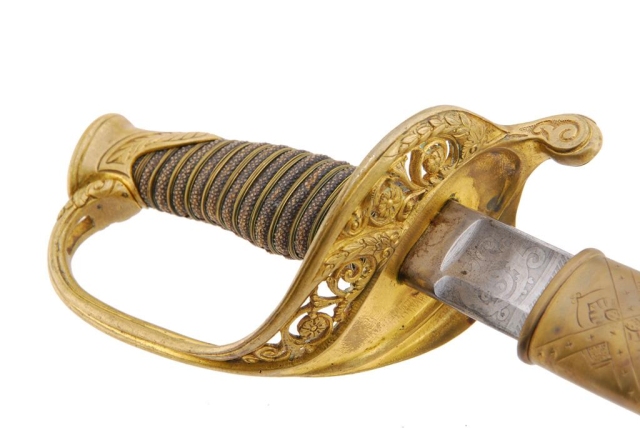 ARIZONA
SWORDS
ARIZONA
SWORDS 
 ARIZONA
SWORDS
ARIZONA
SWORDS 
Identified & Presented Items

CLICK BELOW BUTTONS TO SEE AVAILABLE ITEMS
Beware of fake and misrepresented edge weapons.
Click above to see examples of known fakes!
***********************************************************************************************************
CLICK IMAGES TO SEE MORE PHOTOS
******************************************************************************************************************************
 |
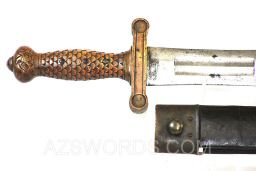 |
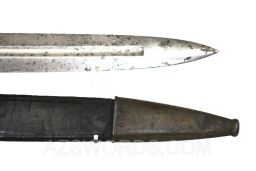 |
 |
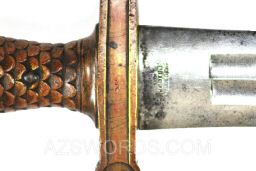 |
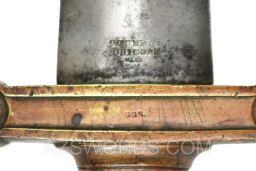 |
 |
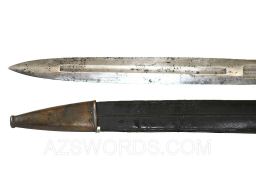 |
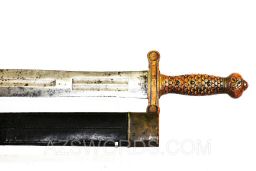 |
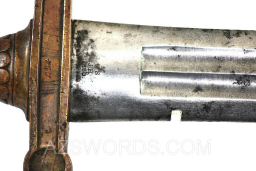 |
 |
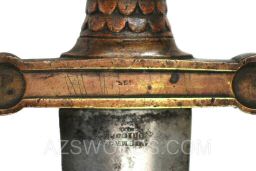 |
CLICK THE ABOVE ICON TO READ THE COMPLETE HISTORY FOLDER
A348: AMES M1832 SHORT ARTILLEY SWORD & SCABBARD 1860 DATED - 1ST VT HEAVY ARTILLEY IDENTIFIED: This Ames Model 1833 Foot Artillery short sword is identified to Private Horace E. Sampson, "D" Co. Vermont 1st Heavy Artillery. However, prior to joining this unit he served in "C" Co. New York 2nd Infantry. Scratched in the swords cross guard is the name H E SAM. A search of the Civil War Data base found only three matches for this name: Horace E. Sampson. One soldier was from Massachusetts and served in the infantry before joining a Heavy Artillery unit, but as a Sergeant and Lieutenant. The second two names are for the same soldier who served in two different units: New York 2nd Infantry & Vermont 1st Heavy Artillery.
With the 2nd Infantry, Horace E. Sampson saw combat Battle of Big Bethel; Battle of Fair Oaks; Seven Days Battles; Battle of Oak Grove; Battle of Glendale; Battle of Malvern Hill; Battle of Bristoe Station; Battle of Groveton; Second Battle of Bull Run; Battle of Chantilly; Battle of Fredericksburg; and was wounded during the Battle of Chancellorsville. He mustered out on 26 May when the New York 2nd Infantry mustered out at the expiration of its term. On 9 November, 1863 Horace E. Sampson enlisted into "D" Co. Vermont 1st Heavy Artillery. What brought him to Vermont was marriage. His widow’s Pension File documents that her husband was from “Troy New York” and “a soldier by occupation,” and he died of Pneumonia on 6 February, 1864.
The sword is an Ames Model 1833 Foot Artillery short sworddated 1860. There were 1000 produced; 500 delivered on February 18, 1860 and 500 delivered on May 3, 1860 making this a Civil War production and very desirable. This hilt has a pleasing patina and the blade is tight with a bright blade with a few minor dark spots. The scabbard is complete with both original mounts and all rivets and has strong leather, which has some crazing. It has matching inspection marks on the drag. Shipping & Insurance is free. $2500.00
******************************************************************************************************************************
 |
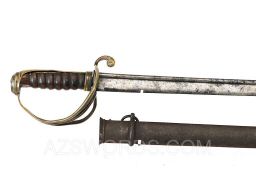 |
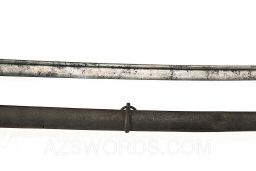 |
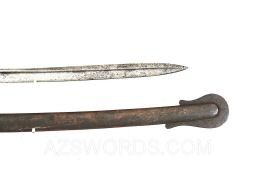 |
 |
 |
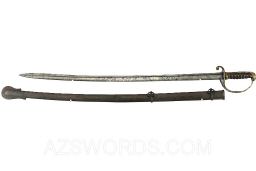 |
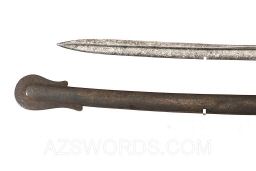 |
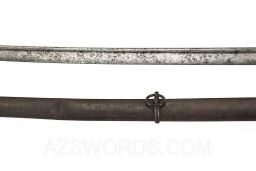 |
 |
 |
 |
 |
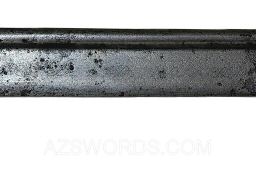 |
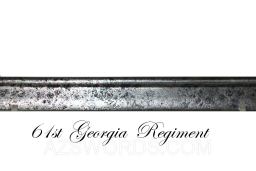 |
 |
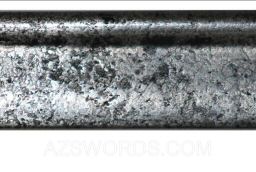 |
 |
CLICK THE ABOVE ICON TO READ THE COMPLETE HISTORY FOLDER
C652. 61ST GEORGIA INFANTRY REGIMENT - AMES MODEL 1833 CAVALRY SABER: This Ames Model 1833 Cavalry Saber is identified to Captain James D. Van Valkenburg and most likely was carried by him during the following battles: Seven Days Battles, Gains Mills, Malvern Hill, Bristoe Station, Groveton/Brawner's Farm, Second Bull Run or Manassas, Sharpsburg/Antietam, and Fredericksburg. No doubt this sword became a war trophy when Captain Van Valkenburg was captured during the battle of Fredericksburg and made a Prisoner-of-War.
This is an early example of an Ames Model1833 Dragoon saber and most likely was a factory special order by Van Valkenburg himself. It is well known that the Ames Manufacturing Company provided swords to the South both before and during the Civil War, and to conceal this activity the maker and inspection marks were often removed as is the case in this sword. The hilt is missing all the leather & wire as well as some original wood, which has caused a little movement in the hilt. The sword shows heavy wear with the guard being bent and Ames and inspection marks removed. On the blade is pen-etched Capt. James D Van Valkenburg and 61st Georgia Regiment on opposing sides. It is exceptionally well done and conforms to the etching style unique to Ames for the period and this pattern sword. The scabbard fits perfect to the blade and has a deep brown patina which has never been cleaned and shows exposure and use consistent with the sabers hilt and blade. Additionally, it has the spit rings common to early produced Ames sabers.
There are three tiny pin holes below the middle mounts as well as two small holes between the ring mounts. These holes were enough to allow moister to enter, which no doubt caused some pitting on the blade and lead to the dark gray patina making it difficult to decern the inscription without magnification and lighting. At the same time, the etching is under the pitting validating its authenticity! Included is a 103-page history binder, and shipping and insurance is free. $6500.00
******************************************************************************************************************************
CLICK THE ABOVE ICON TO READ THE COMPLETE HISTORY
F505. MISSOURI IDENTIFIED - 1853 ENFIELD RIFLE - SERIAL NUMBER BUTT PLATE - JS ANCHOR: This Pattern 1853 Enfield Rifle is identified to William D. Maupin: Missouri State Guard & Missouri 1st Cavalry. Both units fought as dismounted infantry during the war. This is a serial numbered rifle and was in the first lot of 10,000 purchased by the Confederate Government: Serial Number 4868. It is also “S” marked forward of the butt plate and JS-Anchor to the rear of the trigger guard tang. The lock is CROWN and TOWER 1862 marked and properly functions, but the rear sight blade is missing. The bore is dark and nearly shot-out, but you can see faint rifling, and the ram-rod is period with patina that matchedthe rifle.
“W. D. Maupin” is carved on the front side of the butt stock. Some lettered are more pronounced than others, but are present. A search of the Civil War data base and National Civil War records found only one Confederate soldier with this name: Willian D. Maupin. He most likely was issued this rifle when he enlisted in the Missouri State Guard and retained it when it joined the Missouri 1st Cavalry. Both units fought dismounted for most of the war.
He may ormay not have carried it after he assumed command when promoted to Lieutenant Colonel, but we know that whatever he carried at the Battle of Corinth he discarded it to pick up the regimental flag shortly before he was killed.
William D. Maupin began his Confederate service in the Missouri State Guard (MSG) as a Private and Sergeant: date of enlistment unknown. The Missouri State Guard was a military force established by the Missouri General Assembly on May 11, 1861. While not a formation of the Confederate States Army, the Missouri State Guard fought alongside Confederate troops and, at various times, served under Confederate officers. Maupin joined the 1st Missouri Cavalry on December 7, 1861, so it can be surmised he was into the Missouri State Guard between May 11, 1861 & December 6, 1861 and saw action in some of the encounters fought by the Guard.
During his time of service, the Missouri State Guard fought in the following engagements: First Battle of Boonville, June 17, 1861; Battle of Cole Camp, June 19, 1861; Battle of Carthage, July 5, 1861; Battle of Dug Springs, August 2, 1861; Battle of Athens, August 5, 1861; Battle of Wilson's Creek, August 10, 1861; Battle of Dry Wood Creek, September 2, 1861; Action at Blue Mills Landing, September 17, 1861; First Battle of Lexington, September 13 to 20, 1861; Battle of Fredericktown, October 21, 1861; First Battle of Springfield, October 25, 1861.
On December 7, 1861 at the age of 25, William D. Maupin enlisted as a Private into the Missouri 1st Cavalry, and was elected Captain on December 13, 1861; Company A, Missouri 1st Cavalry. He would serve as a captain for 6 months until June 1862 when he was promoted to Lieutenant Colonel and took command: June 29, 1862. His muster sheets document him as a Lt. Col at Priceville, MS, June 15, 1862 and he was engaged at Carthage, Oak Hill, Dry Wood, Lexington, Sugar Creek, Bentonville, Elkhorn, Farmington, Iuka, and Corinth where he was killed on field of battle October 5, 1862. Colonel William D. Maupin (1st Missouri Cavalry, fighting as infantry) fell while bearing the flag of his command after two color bearers had fallen. Shipping & Insurance included. $6700.00
******************************************************************************************************************************
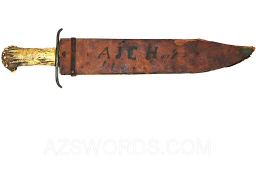 |
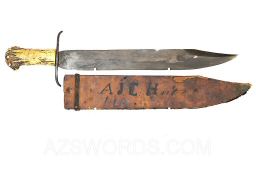 |
 |
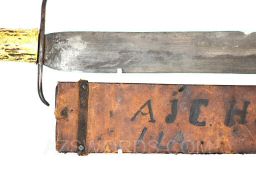 |
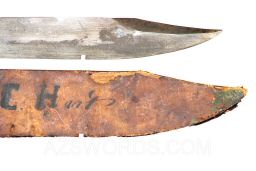 |
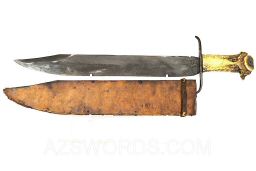 |
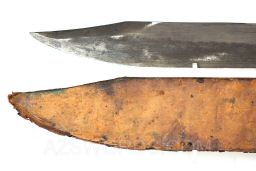 |
 |
 |
 |
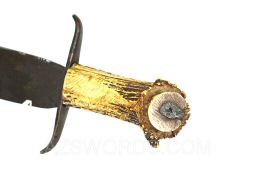 |
 |
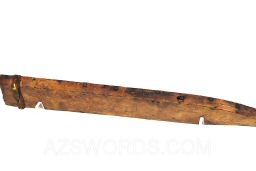 |
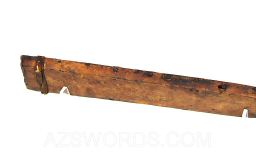 |
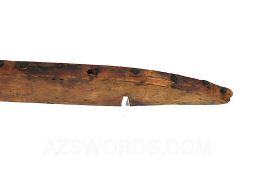 |
 |
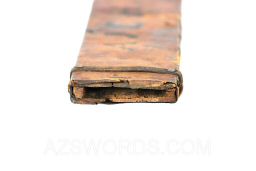 |
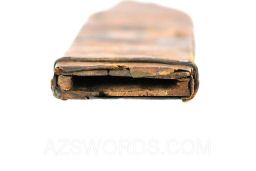 |
CLICK THE ABOVE ICON TO READ THE COMPLETE HISTORY FOLDER
![]() C646. CONFEDERATE BOWIE - COMPANY A, 1ST
LOUISIANA HEAVY ARTILLERY IDENTIFIED: This Confederate
Bowie knife is identified to Private J. C.
Hant Company A, 1st Louisiana Heavy Artillery. The sheath is made of
wood and covered with what appears to be either thin brown card board or a
heavy paper and is marked “A 1 LA”
“J. C. Hant.” The knife is 18
1/2" long with a 14 14” x 1 3/4" clip point blade. It is well made
with a 4 3/8” iron cross guard and a grip made from an antler with the tang
pinned tight and covered with period lead. The sheath is wood that was made to
fit the blade and covered with a heavy paper that is tacked on the underside with
a leather retention band tacked at the top.
C646. CONFEDERATE BOWIE - COMPANY A, 1ST
LOUISIANA HEAVY ARTILLERY IDENTIFIED: This Confederate
Bowie knife is identified to Private J. C.
Hant Company A, 1st Louisiana Heavy Artillery. The sheath is made of
wood and covered with what appears to be either thin brown card board or a
heavy paper and is marked “A 1 LA”
“J. C. Hant.” The knife is 18
1/2" long with a 14 14” x 1 3/4" clip point blade. It is well made
with a 4 3/8” iron cross guard and a grip made from an antler with the tang
pinned tight and covered with period lead. The sheath is wood that was made to
fit the blade and covered with a heavy paper that is tacked on the underside with
a leather retention band tacked at the top.
Private J. C. Hant served with Company A of the 1st Regiment, Louisiana Heavy Artillery (Confederate States Army), a unit that saw significant action in the defenses of New Orleans, and during the Siege of Vicksburg. Specific details regarding his individual record are limited to 4 Muster Sheets and one Prisoner of War document. Nevertheless, his service would have generally followed the path of his company and regiment, to include the defense of New Orleans at Forts Jackson and St. Philip; the defense and capture of Vicksburg; and the subsequent service in the Mobile Alabama area while participation in the defense of Fort Gaines, Fort Morgan, and Spanish Fort. Finally, he was with his command when it surrender at Vicksburg on July 4, 1863, and later at Citronelle, Alabama on May 4, 1865 making him a Prisoner of War twice. He was in active combat service from September 5, 1861 to May 4, 1865 and survived the war. However, his bowie knife most likely became a war trophy for a Union soldier after the fall of Vicksburg. Included with the knife is a 29-page binder; click the above Louisiana State Seal for more information. Shipping & Insurance is included. $6500.00
******************************************************************************************************************************
CLICK THE ABOVE ICON TO READ THE COMPLETE HISTORY FOLDER
"Z"
F477. JOSLYN CARBINE - UNIT ISSUED AND IDENTIFIED & CONFEDERATE RECOVERED & REISSUED: This Joslyn carbine, serial number 993, was used by 2 different soldiers from Company H, 19th New York Cavalry, known as the 1st New York Dragoons. It was first issued to Corporal George Dean, then to Private George Underhill after Dean was wounded at Manassas Junction and assigned to the Ambulance Corps. Underhill would be involved in several engagements and later lose the gun during the fighting at Trevillian Station Virginia on 12 June,1864 when he sustained a gunshot wound of the left leg. The carbine was later Confederate recovered off the battlefield; sent back to Richmond and went through the “C&R” Clean & Repair system at the Richmond Arsenal/Artillery Work shop; inspected by Lous Zimmer and marked with the letter "Z" on the underside, forward of the trigger tang. The gun is fully functional with expected bumps and dings, and is in great shape considering it saw heavy use and action. A 144 page binder on the unit's history and the soldiers is included. Shipping & Insurance included. $6500.00
******************************************************************************************************************************
CLICK THE ABOVE ICON TO READ THE COMPLETE HISTORY FOLDER
A307. PENNSYLVANIA IDENTIFIED HIGH-GRADE STAFF OFFICERS’ SWORD: This is a high-grade presentation quality sword identified to Captain John A. Blake "F" Co. Pennsylvania 3rd Heavy Artillery. The sword was retailed by Bailey & Co. with a Collins & Co. 1862 dated blade and a high-grade hilt with a German Silver grip. The guard design is like a Model 1852 Naval Officers sword with the 13-star eagle pommel cap, but with “US” on the face, and on the inside guard is etched the name “J. A. Blake.” The leather scabbard is complete with high-grade chased mounts and is very attractive. Blake enlisted on 9/1/1862 at Philadelphia, PA as a Captain and mustered out on 11/9/1865 at Fort Monroe, VA.
The 3rd PA Heavy Artillery arrived at Fort Monroe in June1863 comprising much of the garrison for the rest of the war. In the fall of 1863, Captain, afterward Major John A. Blake, with his own company F, and a large number of unassigned recruits, was placed in charge of the prison camp, and camp of distribution, at Camp Hamilton, near Fortress Monroe, which position he retained until the close of the war. He was in command when Confederate President Jefferson Davis was imprisoned in a damp casemate at Fort Monroe, Virginia. Included with the sword is a 99-page binder with historical information. Shipping & Insurance is free. $3600.00
*****************************************************************************************************************************
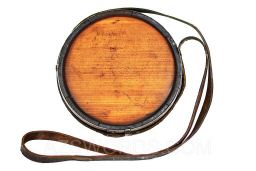 |
 |
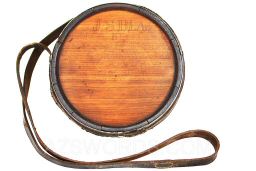 |
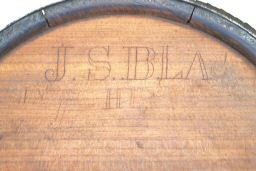 |
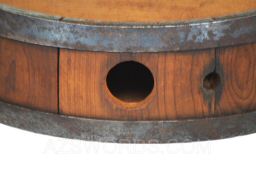 |
 |
 |
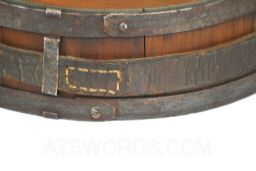 |
CLICK THE ABOVE ICON TO READ THE COMPLETE HISTORY
CN11. CONFEDERATE CANTEEN - IDENTIFIED TO 2 DIFFERENT 17TH REGIMENT ALABAMA INFANTRY SOLDIERS: This Confederate Canteen was carried by two different soldiers from “K” Company, Alabama 17th Infantry: J. Wilkers & Joseph S. Black. On one side of the canteen is carved “Wilkes” above the letter “J” and on the other side “J. S. Blac” and “JS.”
Since there is no identifying unit name or number on the canteen, a deep and thorough search of the Civil War data base and the National Parks records was conducted to see if any Confederate unit had two soldiers with these names. All Southern states were checked and a line-by-line comparison was conducted, and only one match was found: “K” Company, Alabama 17th Infantry. Both soldiers at different time served in this unit.
It appears Private J. Wilkes enlisted into for “K” Company, Alabama 17th Infantry when the unit was formed in August, 1861. He was wounded at the Battle of Shiloh and later died at a temporary Confederate hospital located in Macon Mississippi.
Following the Battle of Shiloh April 6-7, 1862, the injured and wounded were loaded on trains and sent to surrounding communities for care. For a battle which lasted only two days, there were nearly 24,000 dead, wounded, or missing and there were just not enough facilities to care for everyone. Shiloh is not far from Macon just north of Corinth, a little over 160 miles, so many of those wounded men ended up in Macon, Brooksville, Shuqualak, and other towns along the railroad lines. The communities opened their churches, schools, and homes to the wounded setting up temporary hospitals to treat the wounded.
A date of death, or cause, was not given for Private J. Wilkes; however, his personal effect and most likely all his equipment, to include his canteen, were received 2 September, 1862. Since this was early in the war and the supply systems was still being established, most equipment and weapons were retained by the original command for reissue.
A few months after the death of Private J. Wilkes, Private Joseph S. Black enlisted on Feb. 26, 1863 into “K” Company, Alabama 17th Infantry. He would be issued a weapon and military equipment to include a canteen. Black would go on to fight at the Battle of Franklin and Battle of Nashville on December 16, 1864 and was captured and sent to Camp Douglas as a Prisoner-of-War. His name would appear on a Muster Sheet Roll of Prisoners of War at Camp Douglas, Ill being mustered into 6th U.S. Vol. Infantry April 3, 1865.
No doubt the canteen became a war trophy and survivedcomplete with its original Confederate leather strap. Include is a history binder. Shipping & Insurance is included. $4500.00
******************************************************************************************************************************
 |
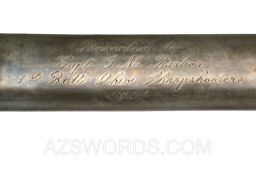 |
 |
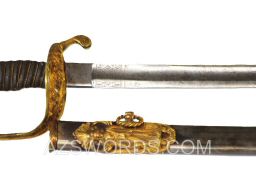 |
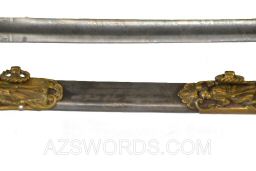 |
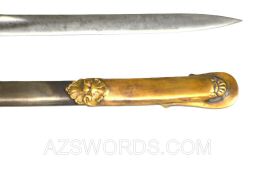 |
 |
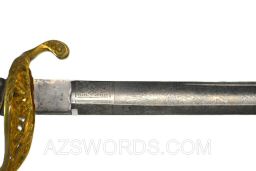 |
 |
 |
 |
 |
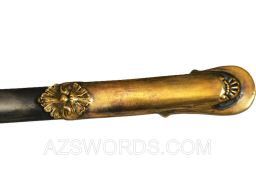 |
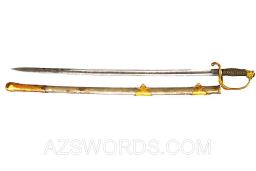 |
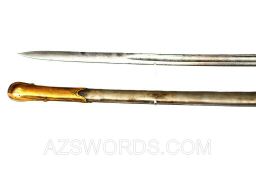 |
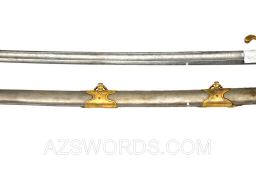 |
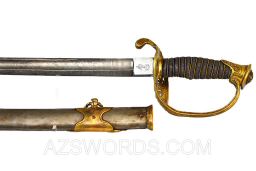 |
 |
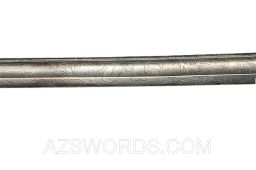 |
 |
CLICK THE ABOVE ICON TO READ THE COMPLETE HISTORY
Presented to
Capt. G. M. Barber
1 st. Batt. Ohio Sharpshooters
1864
A342. PRESENTATION SWORD – 5TH OHIO SHARP SHOOTERS - 1ST BATTALION, OHIO SHARPSHOOTERS: This Clauberg made, James P. Fitch retailer sword was presented to Captain Gershom M. Barber. Barber entered the Civil War as a 2nd lieutenant in Oct. 1862. From March 1863 – April 1865, he commanded a battalion of sharpshooters, attaining the rank of captain.
The 1st Ohio Sharpshooters Battalion was an irregular sharpshooter battalion in the Union Army during the American Civil War that specialized in ambush, close combat, irregular warfare, long range shooting, reconnaissance in dangerous areas, screening, and tracking targets. Barber participated in all its battles to include Chickamauga, Mission Ridge, Atlanta, and Nashville.
Toward the war's end, Barber was promoted to Lieutenant-Colonel in command of the 197th Ohio Infantry, and was recommended by General Thomas for a brevet commission of brigadier general. In June and July 1865, he served as president of the Military Examining Court.
The sword is a German Silver hilt Foot Officers sword with both maker and retailer marks. The grip is tight with original twisted brass wire, but there appears to be some loose metal inside the grip. It is only noticeable when you move the sword. The blade has strong deep etching and no pitting or rust. The steel scabbard has high-grade ornate mounts with the presentation between the top two carry mounts. Included is a 129-page history binder. Free insurance & shipping. $4500.00
******************************************************************************************************************************
CLICK THE ABOVE ICON TO READ THE COMPLETE HISTORY
C642. CONFEDERATE D-GUARD BOWIE – VIRGINIA MADE & IDENTIFIED – GETTYSBURG – POW: This is a well-made Virginia D-Guard Bowie knife complete with its original leather sheath. It is 21 inches long with a 16 1/4-inch clip-point blade made from a file and a nicely shaped D-Guard with a beautifully shaped walnut grip. The blade has period sharpening and several contact marks indicating it saw combat. The original leather sheath is complete, but the bottom seam is partially open where the cotton threads have been cut. On the top of the grip is carved the name: H. Korner.
A search of the National Parks Soldiers and Sailors Database & the Civil War Database reveals there are only six Confederate soldiers with the last name Korner and only one with the first name initial “H” and that is Harmer D. Korner. The alternate names of Hiram C. Koiner and Hiram D. Koiner are listed, but this is a result of two soldiers Muster Sheets being inadvertently merged. There are only three known muster sheets for Private Harmer D. Korner. His enlistment date is unknown, but can be assumed to be early when the 52nd Virginia Infantry Regiment was formed in August 1861. He most likely was with the command during all its engagement up to and including the Battle of Gettysburg. The 52nd Virginia infantry regiment was heavily engaged at Culp’s Hill on 3 July and began the retreat the following day.
During the Confederate Army of Northern Virginia's retreat following the Battle of Gettysburg, Union cavalry captured over 500 Confederate soldiers in the vicinity of Clear Spring, Maryland. These troops were taken during a series of skirmishes between the two sides as they maneuvered towards the Potomac River crossings. Private Harmer D. Korner last muster sheet documents his capture at Clear Springs Maryland. A 21-page history binder, and shipping and insurance is free. $12,000
******************************************************************************************************************************
 |
 |
 |
 |
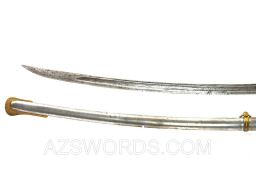 |
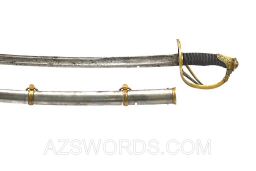 |
 |
 |
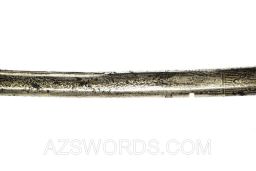 |
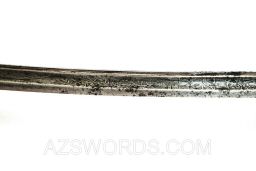 |
 |
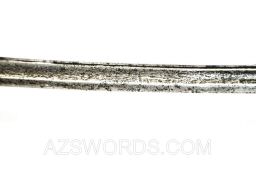 |
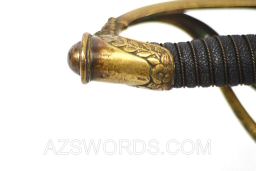 |
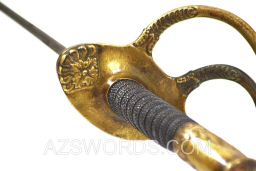 |
 |
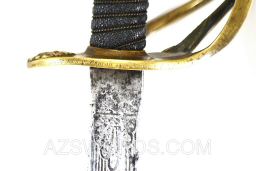 |
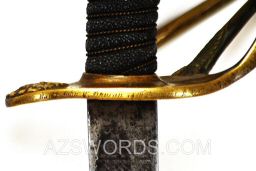 |
 |
CLICK THE ABOVE ICON TO READ THE COMPLETE HISTORY FOLDER
A329. PENNSYLVANIA ID’ED CAVALRY OFFICERS SABER - VOLUNTEER AIDE-DE-CAMP TO MAJOR GENERAL JOHN F. REYNOLDS: This is a Klingenthal France Model 1860 Cavalry Officers saber made for the American market for the Civil War. Klingenthal means "Blade Valley" or "The Valley of Blades" and swords produced there where of a high quality. The two things to look for to differentiate an American sword from its French counterpart is the scabbard mounts and the etching. A French saber has one carry ring whereas the American version had two on the scabbard, and the American saber will have US etching. This sword is the American version with two brass ring mounts with brass rings, US etched on the blade, and more importantly there is a Pennsylvania Officer identification on the knuckle-bow. This hilt is tight with 100% ray-skin grip and twisted brass wire. The original blade washer holds the blade tight and is Klingenthal marked on the spine, and though the etching is a little tired, you can clearly see the US. On the knuckle-bow is etched:
“Major John W Duncan 8th Regiment R. V. C.”
The Military Order of the Loyal Legion of the United States, Register of the Commandery of the State of Pennsylvania List John William Duncan as a Major 37th Penna, Infantry (8th Reserve Volunteer Corps) July 21, 1861; resigned and honorably discharged Nov. 21, 1861. Volunteer Aide-de Camp with the rank of Major on the staff of Major-General John F. Reynolds U.S. Volunteers Nov. 22, 1861, to July 1, 1863. This potentially places him with General Reynolds on many battlefields to include Gettysburg.
Major John W. Duncan was born in Allegheny County in the year 1827 and while quite young, he entered Washington and Jefferson college, and graduated from that institution with high honors. Soon afterward he was married to Miss Martha Shoenberger, daughter of the great iron master, Peter Shoenberger. With the direct training and backing by the resources of his father-in-law, young Duncan soon became an active and prominent iron operator, and for thirty years he had been the iron king, so to speak, of Blair County.
As a well-known ironmaster of Philadelphia with a national reputation as an iron master and capitalist, his operations extended over the entire State. During the war his furnaces at Bloomfield County supplied the greater part of the cannon metal used by the Fort Pitt cannon foundries at Pittsburgh, and he was at that time considered one of the best authorities on iron ordnance in the country. His personal service during the war was also very valuable, having won great honors in his military career.
As a captain, he formed the “Duncan Guards” and reported to Camp Wilkins, Military Post in Pittsburgh, May 1861. This company would become Company “E” 8th Pennsylvania Reserve Regiment, also known as the 37th Pennsylvania Volunteer Infantry Regiment. He would promote to Major on 6/22/1861 and move with his command to Virginia were the regiment was sent to support the 7th Reserves, which had been “vigorously” shelled by Confederate artillery during the Skirmish at Great Falls. The Skirmish at Great Falls refers to a clash between Union and Confederate forces near Great Falls, Virginia on July 9, 1861, when a Confederate force approached Major Gerhardt's Union command. The skirmish resulted in the deaths of two Union soldiers. However, Major Duncan’s service with the 8th Pennsylvania Reserve would end when he resigned on 11/21/1861 to join the staff of Major General John F. Reynolds as a Volunteer Aide-de-Camp U.S. Volunteers - Nov. 22, 1861 to July 1, 1863.
A Volunteer Aide-de-Camp is different than a Military Aide-de-Camp. It is an individual, often a civilian or a member of the military or other uniformed service, who serves as a personal assistant and advisor to a person of high rank or senior military officer in a volunteer capacity, and unpaid. They assist with a variety of tasks. No doubt Duncan was independently wealthy and influential, and had skills and knowledge on iron ordnance that was beneficial to General Reynolds.
He was part of the general’s staff during the following engagements and most likely was on these battle fields: Seven Days Battles, Second Battle of Bull Run, Battle of Fredericksburg, Battle of Chancellorsville, Battle of Gettysburg. His service to the general came to an end when Reynolds was killed at Gettysburg on July 1, 1863. On September 18, 1884 at the unveiling of the statue of General John F. Reynolds in Philadelphia Major John W. Duncan participated as one of the division marshals. Shipping & Insurance included. $4500.00
*****************************************************************************************************************************
 |
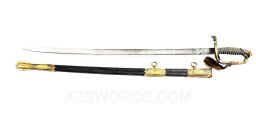 |
 |
 |
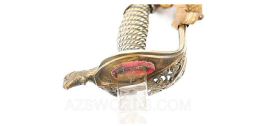 |
 |
 |
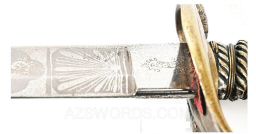 |
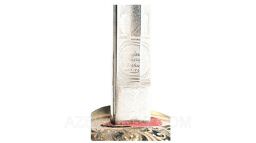 |
 |
 |
 |
 |
 |
 |
 |
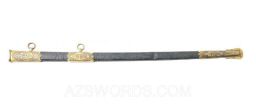 |
 |
CLICK THE ABOVE ICON TO READ THE COMPLETE HISTORY
Presented to
LIEUT, Wm H. WRIGHT
BY
Che Members of Company G
56th Regt. N.G.S.N.Y.
July 28th 1863
A326. HIGH-GRADE - CIVIL WAR MODEL 1850 FOOT OFFICER'S PRESENTATION SWORD: This high-grade Civil War Model 1850 Officer’s Presentation sword was awarded shortly after Gettysburg Campaign to First Lieutenant William H. Wright, G Company 56th Regiment N.G.S.N.Y. As General Robert E. Lee moved his army north, the 56th regiment was ordered to Harrisburg Pennsylvania for a service of thirty days. It left the State June 19, 1863, and served in the Third Brigade, 1st Division, Department Susquehanna, and July 24, 1863, it was mustered out of the service of the United States at Brooklyn. August 2, 1864, it was mustered into the United States service for 100 days and it served at Elmira until it was mustered out November 6, 1864.
The regiment in its service in 1863 took part in a skirmishnear Oyster Point, Pa., June 29, 1863, and it lost in its service in 1864, by death, of disease, two enlisted men." One veteran of the battle at Oyster Point recounted: "While this skirmish was of no particular account in itself, it is really historic. It was at the furthest northern point which was reached by the invaders, and marks the crest of the wave of the invasion of Pennsylvania. The retreat of the Confederate force there commenced did not end until the Potomac was crossed. The success obtained must be largely ascribed to the gallant conduct of Landis’ Battery...” The skirmish lasted for two days and ended when Robert E. Lee issued orders for the troops to retreat south on June 30th for the Battle of Gettysburg. The Union militia pursued the invaders and fought them in another skirmish at the Battle of Sporting Hill.
The scabbard is black leather with gilt brass fittings. Theupper suspension band of the scabbard is inscribed "LIEUT WM H. WRIGHT/BY/the Members of Comp G 56th Regt N.G.S.N.Y. July 28th 1863" on the reverse, and the rest of the fittings have floral engraving. The 32-inch blade has patriotic, floral, and martial etching patterns with frosted backgrounds, "Schuyler-/Hartley-/& Graham/New-York" etched above the right ricasso and "W./CLAUBERG/knight logo/SOLINGEN" stamped on the left ricasso. The silver-plated cast brass hilt has floral patterns and a cast brass rope pattern grip that had a silver-plated finish. A gilt sword knot is fitted to the knuckle guard. A very fine sword! The blade is mostly the untouched original bright polish and has crisp acid etching, some faint spotting, and generally minimal wear. The hilt has aged patina. The grip has traces of silver and otherwise aged patina. The sword knot has moderate age and storage related wear. The scabbard is fine and has moderate wear on the leather, mostly aged patina on the fittings, and distinct engraving and inscription. This is a very attractive Civil War presentation sword complete with a historical inscription to a New York officer from a unit that fought in one of the northernmost skirmishes of the Civil War during Gettysburg campaign. Included is a 19-page history binder, and Shipping & Insurance. $4800.00
*****************************************************************************************************************************
 |
 |
 |
 |
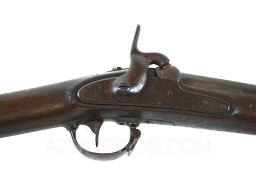 |
 |
 |
 |
 |
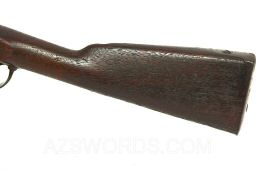 |
 |
 |
CLICK THE ABOVE ICON TO READ THE COMPLETE HISTORY FOLDER
F508. TEXAS 16TH INFANTRY REGIMENT-IDENTIFIED MODEL 1842 SPRINGFIELD MUSKET: This Model 1842 Springfield smoothbore musket is identified to and carried by Private David N. Henry of Co. “G” 16th Texas Infantry.
Companies G, 16th Texas Infantry was a Confederate unit raised in Texas and mustered into service as part of the 16th Texas Infantry Regiment, which served in Walker’s Texas Division. Organized in 1862, the regiment primarily operated in the Trans-Mississippi Theater, defending Confederate interests in Texas, Louisiana, and Arkansas. Companies G participated in key engagements such as the Red River Campaign in 1864, including the battles of Mansfield and Pleasant Hill, where Walker’s Division played a crucial role in repelling Union advances. The 16th Texas Infantry endured the hardships of war, often facing supply shortages and difficult terrain, yet remained a steadfast force until the war’s end. Their service highlights the dedication and perseverance of Texas soldiers in the Western Confederate Army.
The musket was purchased in the mid-1970’s from direct descendants of the Henry family and was in the Ken Bilbrey’s collection until 2015 when it was acquired by Larry Hicklen of Middle Tennessee Civil War Relics. Larry sold it to a collector who just sold it early 2025. Hicklin’s original sales letter is included.
The musket is all original and complete and has a deep brown patina on all metal. The lock plate is marked SPRINGFIELD 1846 and properly holds in both half and full cock positions. On the top sling swivel is the tag from Bilbrey’s collection which reads “Picked up at Henry farm.” On the left stock is carved “HENRY” and right stock is carved “D. N. H” with some unreadable letters.
Included with the musket is a 36-page history binder. Shipping and insurance are included. $4000.00
*****************************************************************************************************************************
 |
 |
 |
 |
 |
 |
 |
 |
 |
 |
 |
 |
Lieutenant Jesse F. Eddy
CLICK THE ABOVE ICON TO READ THE COMPLETE HISTORY FOLDER
A325. 7TH MASSACHUSETTS – IDENTIFIED MODEL 1850 FOOT OFFICERS SWORD: This sword is identified to Lieutenant Jesse F. Eddy, “A” Company Massachusetts 7th Infantry Regiment. He enlisted on 15 June, 1861 and resigned 23 March, 1863, and though his service was less than 2 years he saw the elephant. His Muster Sheet show he was present with his command during the Siege of Yorktown April 5-May 4; Battle of Williamsburg May 5; Bottom's Bridge May 19-21; Reconnaissance toward Richmond May 23; Battle of Fair Oaks, Seven Pines, May 31-June 1; Seven days before Richmond June 25-July 1; Oak Grove, near Seven Pines, June 25; James River Road, near Fair Oaks, June 29; and Malvern Hill July 1. After which, he was on Special Duty as the Acting Ordnance Officer of the Division. A position he held until discharged March 1863 due to heath issues.
The sword is a standard French import Model 1850 Foot Officers sword with a plain blade, but maker marked on the top spine. The hilt is tight with no movement, but shows wear on the grip which retained the original twisted wire. The blade has some spotting and period sharpening with some nicks. The scabbard leather is complete, but flimsy and weak with all original mounts. The top throat mount is identified to Jesse F Eddy May 1861.
Due to the weakness of the scabbard a wooded dowel is attached to keep it secure. Included with the sword is a 56-page history binder and the framed image. Shipping & Insurance is free as well as 3 sword display stands for proper support. $2600.00
******************************************************************************************************************************
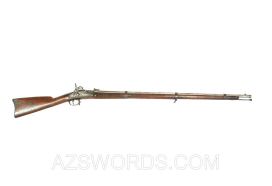 |
 |
 |
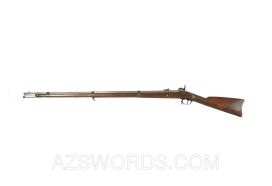 |
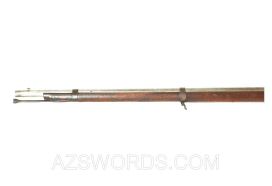 |
 |
 |
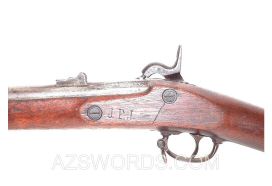 |
 |
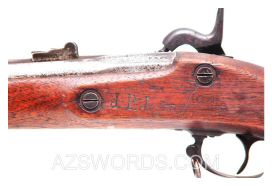 |
 |
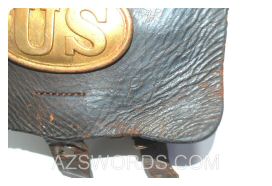 |
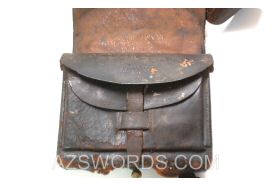 |
 |
 |
 |
 |
 |
 |
 |
 |
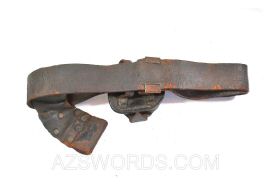 |
 |
 |
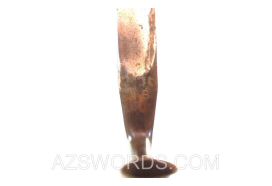 |
F435. OHIO ID’ED & CARRIED CONTRACT RIFLE, CARTRIDGE BOX, BELT, CAP BOX AND BAYONET: This grouping was acquired from a direct descendant of Private John P. Johnson. He served in the 177th and the 180th Ohio Volunteers.
The 177th Ohio Volunteers Regiment was organized at Camp Cleveland, Ohio; mustered in October 9, 1864; Ordered to Nashville, Tenn.; thence to Tullahoma, Tenn., and garrison duty there under General Milroy till November 30. Ordered to Murfreesboro, Tenn., November 30, arriving there December 2. Attached to Defences Nashville & Chattanooga Railroad, Dept. of the Cumberland, to January, 1865. 2nd Brigade, 3rd Division, 23rd Army Corps, Army of the Ohio, and Dept. of North Carolina, to June, 1865. It’s service includes the Siege of Murfreesboro December 5-12, 1864. Wilkinson's Pike, near Murfreesboro, December 7. Near Murfreesboro December 13-14. Ordered to Clifton, Tenn., and duty there till January 16, 1865. Movement to Washington, D. C., thence to Fort Fisher, N. C., January 16-February 7. Operations against Hoke February 11-14. Near Sugar Leaf Battery February 11. Fort Anderson February 18-19. Town Creek February 19-20. Capture of Wilmington February 22. Campaign of the Carolinas March 1-April 26. Advance on Goldsboro March 6-21. Occupation of Goldsboro March 21. Advance on Raleigh April 10-14. Occupation of Raleigh April 14. Bennett's House April 26. Surrender of Johnston and his army. Duty at Raleigh and Greensboro till June. Mustered out at Greensboro, N. C., June 24, and discharged July 7,1865. The 180th Ohio Volunteers Regiment was organized at Camp Chase September-October, 1864. Left State for Nashville, Tenn., October 15. Attached to 3rd Brigade, Defences of Nashville & Chattanooga Railroad, Dept. of the Cumberland, to January, 1865. 1st Brigade, 1st Division, 23rd Army Corps, Army of the Ohio, and Dept. of North Carolina, to July, 1865. It’s service includes the moved from Nashville to Decherd, Tenn., October, 1864, and guard duty on line of the Nashville & Chattanooga Railroad, Right Wing at Decherd, Left Wing at Elk River Bridge, till January, 1863. Moved to Nashville, Tenn., January 6; thence moved as Train Guard to Columbia, Tenn., January 10. Return to Nashville and movement to Washington, D. C.; thence to North Carolina January 16-February 25. Campaign of the Carolinas March 1-April 26. Advance on Kinston and Goldsboro March 6-21. Battle of Wise's Forks March 8-10. Occupation of Kinston March 14. Occupation of Goldsboro March 21. Advance on Raleigh April 10-14. Occupation of Raleigh April 14. Bennett's House April 26. Surrender of Johnston and his army. Duty at Raleigh, Greensboro and Charlotte, N. C., till July. Mustered out July 12, 1865.
The 180th Ohio Volunteers Regiment was organized at Camp Chase September-October, 1864. Left State for Nashville, Tenn., October 15. Attached to 3rd Brigade, Defences of Nashville & Chattanooga Railroad, Dept. of the Cumberland, to January, 1865. 1st Brigade, 1st Division, 23rd Army Corps, Army of the Ohio, and Dept. of North Carolina, to July, 1865. It’s service includes the moved from Nashville to Decherd, Tenn., October, 1864, and guard duty on line of the Nashville & Chattanooga Railroad, Right Wing at Decherd, Left Wing at Elk River Bridge, till January, 1863. Moved to Nashville, Tenn., January 6; thence moved as Train Guard to Columbia, Tenn., January 10. Return to Nashville and movement to Washington, D. C.; thence to North Carolina January 16-February 25. Campaign of the Carolinas March 1-April 26. Advance on Kinston and Goldsboro March 6-21. Battle of Wise's Forks March 8-10. Occupation of Kinston March 14. Occupation of Goldsboro March 21. Advance on Raleigh April 10-14. Occupation of Raleigh April 14. Bennett's House April 26. Surrender of Johnston and his army. Duty at Raleigh, Greensboro and Charlotte, N. C., till July. Mustered out July 12, 1865.
Private John P. Johnson’s mustersheets places him predominantly with the 180th Ohio Regiment, but there is one pages placing him with the 177th. His initials J. P. J. are carved into the flat side of the rifle stock opposite the lock; on the cartridge box outer flap, and the cap box. The contract rifle is marked 1864 / EAGLE over U.S. / PARKER, SNOW COMPANY OF MERIDEN, CONN. Rifle comes complete with its three original barrel bands, hammer, bolster, lock plate and screws, rear / front sight, both swivels and its swelled shank ramrod. All screws very good and not buggered up and the butt plate is stamped “US”. There is a faint ghost image of rifling, but is now smooth bored. The early Cartridge box has its original brass plate and the two tin inserts, and the sling has its original brass plate as well, but the leather is damaged on the bottle where the sling would attach. Inside I found the original retainer flap retainer strap, the buckle for the sling, a length of twine and a gun tool. On the outer flap, lower right-hand side, Private Johnson carved his initial J. P. J. The belt is complete and has the original puppy paw oval U.S. brass plate, a cap box and the bayonet frog. The initials J. P. J. are on the outer flap of the cap box. The Cartridge box, belt, cap box, and bayonet sheath all have seen better days, but are part of the group. Included is a a folder with copies of Private John P. Johnson’s muster sheets and pension file. Shipping & Insurance included. $4200.00
******************************************************************************************************************************
****************************************************************
Remittance by Mail
Send to:
Arizona Swords
530 E. McDowell Road, Suite 107-160
Phoenix, AZ 85004
****************************************************************
Contact Number: (602) 245-4721
© 2004 Arizona Swords azswords.com. All rights reserved in all media.